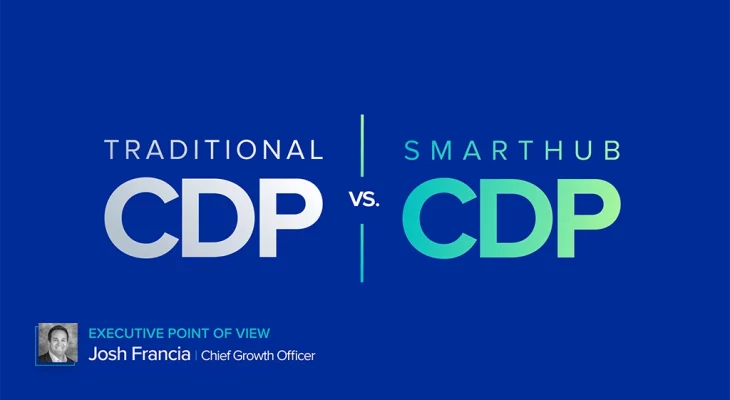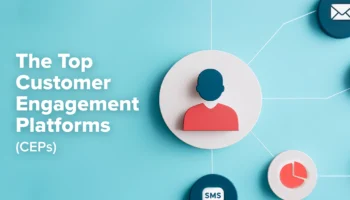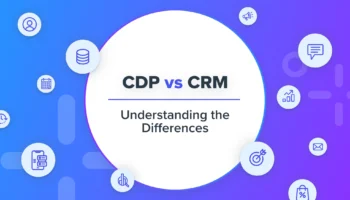The customer data platform (CDP) space has been on fire in recent years, and it’s showing no signs of slowing down. As the market continues to grow, subcategories of CDPs are forming. The biggest two subcategories are traditional “pure play” CDPs and SmartHub “activation” CDPs. Below, we’ll explore the differences between a traditional CDP — such as Treasure Data, Segment, Mparticle, Amperity, etc. — and a SmartHub CDP like Blueshift
Traditional CDP vs. SmartHub CDP

TRADITIONAL CUSTOMER DATA PLATFORMS
Why They Don’t Measure Up
Traditional customer data platforms do three main things:
- Organize anonymous and known identities into unique customer profiles.
- Provide predictive scores — generally non-configurable, out-of-the-box models for churn, purchase, and engagement.
- Segment and push audience data to various destinations, including email and mobile marketing platforms.
Essentially, traditional CDPs provide a lot of insight to the companies using them but no real value to the customer, because they don’t directly activate the customer; they rely on pushing audiences to third-party platforms that handle the message creation and activation. Companies are required to purchase separate campaign management platforms for the various channels needed to complete the customer experience.
Think of it like this: traditional CDPs are hard drives that store customer data but can’t access or activate any of that data without the help of a computer. Campaign management platforms are like computers that can execute commands but don’t have access to any of the data. In order to get the maximum value from both of these forms of technology, they need to be combined.
Using disparate platforms inevitably leads to disconnected customer experiences. In fact, a recent study suggested that 89% of consumers have moved to a competitor following a poor customer experience with a brand.
Customers don’t think in terms of channels — they are looking for a holistic brand experience and fully expect that, no matter what channel on which they engage, the experience is unified and consistent. If they receive an omnichannel brand experience, they are more likely to purchase, remain loyal to the brand, and deliver high lifetime value.
SMARTHUB CUSTOMER DATA PLATFORMS
What Gives Us an Edge
SmartHub CDPs do all the same things as traditional CDPs with the addition of four important features:
- Build and personalize marketing templates (email, mobile, etc.) directly inside the platform.
- Orchestrate and automate customer journeys on a 1:1 user level across all channels and use real-time data from those channels, such as click behavior, to automatically adjust those journeys.
- Upload and manage product and content catalog data, as well as build recommendations based on customer behavior and predictive affinities.
- Report on and analyze both customer and campaign metrics, including A/B testing and holdout reporting.
Essentially, SmartHub Customer Data Platforms combine CDP and campaign management features into one seamless platform, allowing companies to directly activate their customers, consolidate their martech stacks, reduce cost, and drive increased efficiencies.
Of course, companies can choose a traditional CDP and a campaign management platform — and that can work, but it is a significantly inferior choice to a combined offering (a.k.a., a SmartHub CDP). As anyone who has tried to use an external hard drive with their computer for any length of time knows, it is clunky, inefficient, and ultimately doesn’t meet expectations.
Because all customer data and orchestration is in one place, a SmartHub Customer Data Platform further helps companies in the following ways:
- Enables the ability to react in real time to events instead of having delays when pushing from system to system.
- Maintains data fidelity since data doesn’t need to be translated from system to system.
Saves approximately 30 to 50 hours per week across marketing teams who are able to work faster and more efficiently. - Reduces costs associated with paying for two separate systems and maintaining the necessary connections and data flows.
- Provides a single place for consent management and compliance across all channels (email, push, SMS, etc.) and legislation (CAN-SPAM, GDPR, CCPA, etc.).
Companies are eager to consolidate their bloated martech stacks to drive higher efficiencies and increased revenue. A SmartHub Customer Data Platform like Blueshift helps marketers like you do just that.
Schedule a demo with a Blueshift expert today to learn more about what sets our SmartHub CDP apart.


